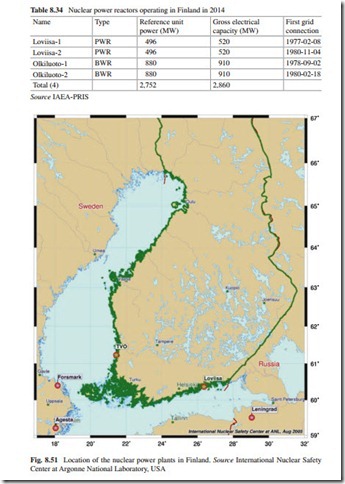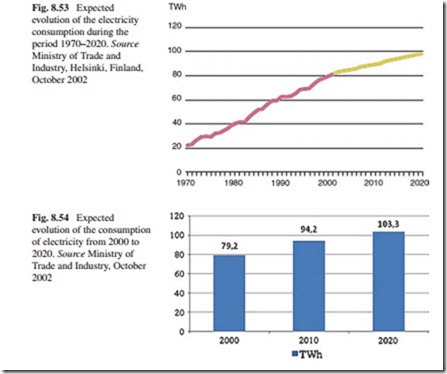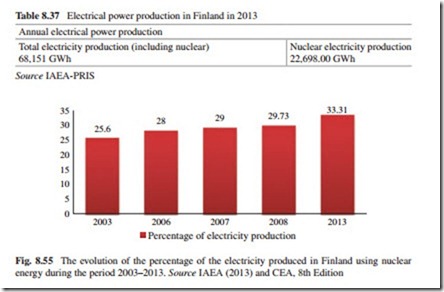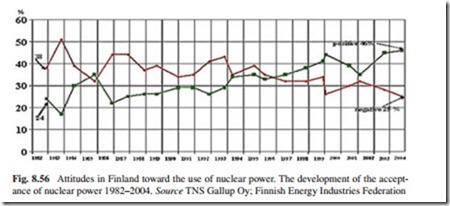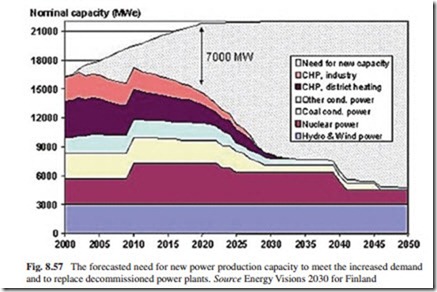Finland
Almost all activities that a modern society has to carry out to provide a high stand- ard of living are based on a secure supply of electricity. Industries, school and universities, laboratories, research centers, hospitals, government offices, restaurants, etc., consume a lot of electricity. Finland’s energy challenges are not very different from the ones that many other countries are facing today. One of these challenges is the following: Energy consumption is on the rise and this means the possibility of increases the CO2 emission to the atmosphere at the time when the government has committed to reduce the country’s greenhouse gas emissions due to the Kyoto Protocol. As a consequence of this commitment, the Finland’s government has to close several coal-fired power plants and substituting their output with clean energy from alternative sources. How to achieve this goal in a country without important energy sources? According to government information, it is true that Finland has no natural oil or gas reserves to exploit, does not produce crude oil and, for this reason, should import crude oil to be processed by its refineries or import the end product. Finland does not produce any coal either. Russia is the most important supplier of crude oil, coal, and gas to Finland. In addition, the country imports crude oil from Denmark and UK and hard coal from Poland and the USA.
According to 2001 statistics, in Finland, the total primary energy consumption per capita was about 65 % higher than the EU average and about 39 % higher than the OECD average. According to IAEA source, this is mainly due to the weather, which demands space heating for most of the time, and the structure of the industry, which is an energy-intensive processing industry (wood, especially paper, heavy metal, and chemical). A third factor is relatively high transportation requirements per capita caused by the low population density.
Finland has four nuclear power reactors in operation in Loviisa (WWER type) and in Olkieluoto (BWR type) nuclear power plants, with a net capacity of 2,752 MW in 2014 (see Table 8.34 and Figs. 8.51 and 8.52). Finland’s four
nuclear power reactors are among the world’s most efficient, with average capacity factors over 94 %. They have an expected operating lifetime of 50–60 years, though were originally licensed was for only 30 years. Finland is now constructing a new nuclear power reactor with a capacity of 1,600 MW and has plans to con- struct another two units with a capacity between 2,600 and 2,800 MW in the com- ing years35 (see Tables 8.35 and 8.36).
The construction of Olkiluoto 3 has suffered several delays increasing the construction cost considerably. Construction started May 2005, but delays have been encountered, particularly in the reactor section. SIEMENS and its subcon- tractor supplied the turbine section much quicker. The most recent delays to the plant’s schedule have centered on the reactor instrumentation and control system, which gained approval from STUK in April 2014 after four years of what AREVA described as “exchanges” between the constructor and TVO. Completion of con- struction and start of commissioning are now expected in mid-2016 with commer- cial operation in 2018 according to AREVA, though TVO anticipates an earlier date, but this date could once again change.
The cost overrun is considerable, possibly €8.5 billion and AREVA has already made provision for write-down of €2.7 billion on the €3.3 billion project in its accounts, though in mid-2014 AREVA’s losses to completion were €3.9 billion. In
December 2011, the unit was 82 % complete. The AREVA-SIEMENS consortium is claiming €2.7 billion against TVO in relation to the delay and cost overruns of the project to June 2011. The claim includes around €70 million of payments delayed by TVO under the construction contract, some €700 million of penalty interest and €120 million of the alleged loss of profit. TVO has counterclaimed for
€1.8 billion for losses to the end of 2014 and has since revised its loss figure to €2.3 billion by the end of 2018.
The Energy Policy in Finland
The main objectives of the Finnish energy policy are the following:
• Security of supply;
• Effective energy markets and economy;
• Environmental acceptability;
• Safety.
In Finland, energy supply decisions on energy systems take place at a fairly decen- tralized level with the exception of nuclear power. A substantial proportion of energy is imported and produced by private enterprises. The energy companies with majority ownership by the state are also run on a purely commercial basis (Finland-IAEA country file 2004).
In 1994, Finland ratified the Framework Convention on Climatic Change of 1992. According to the Kyoto Protocol of 1997, Finland’s commitment is to return the emissions to the 1990 level. Meeting the emission limits, especially those of carbon dioxide, would be a challenging task without the expanded use of nuclear energy and renewable energy sources for electricity generation. Other actions that have been taken in this regard are the use of wood-based fuels, natural gas, a sub- stitute for coal, as well as upgrading the current nuclear power reactors in operation in the country. Energy conservation has also played an important role within the actions already taken.
According to IAEA sources, the Finland National Climate Strategy lays down guidelines as to how Finland will meet the targets for greenhouse gas reduction agreed upon in the Kyoto Protocol. Preparatory work was started in 1999, and the strategy was approved by the government in March 2001. Later the same year the Finnish parliament endorsed it in a statement.
On the other hand, it is foreseen, according to recent studies carried out by the Ministry of Trade and Industry, that the consumption of electricity is expected to evolve from the 2000 level of 79.2–103.3 TWh in 2020, with an average annual economic growth of at least 2.5 % for the next 30 years, with the purpose of ensur- ing a high standard of living for the Finnish population (see Figs. 8.53 and 8.54).
Within the above time frame, it is expected that the growth of primary energy use in the country to satisfy its energy needs slow down and even cease. However, new electricity production capacity is needed to meet the expected increase in power demand in the coming years and to compensate the decommissioning of older power plants. Finland has to take a decision about which forms of energy production it is going to support in the coming years. Increasing the use of nuclear energy for electricity production is currently under scrutiny, along with a debate about the viability of using different renewable energy sources, despite of the fact that recent studies have shown that the use of nuclear energy for electricity genera- tion was the cheapest energy option for Finland.
The government’s role in nuclear power projects is to grant licenses and monitor the safety of the reactor’s operation. According to the government’s position,
a high level of safety is a precondition for the construction and operation of a nuclear power plant in Finland. “When it comes to the use of nuclear energy, safety always comes first,” emphasizes Riku Huttunen, Deputy Director General, Ministry of Employment and the Economy. But not only safety considerations are taken into account, but also environmental impact, raw materials used, and future self-sufficiency. All of these elements are key factors that could affect the choice of the energy source to be used for the production of electricity in the future.
Finally, it is important to highlight that the Finland current ratio of imported electricity is among the highest in Europe and this made the country very vulner- able to any political and economic changes in the situation of the countries where the energy is imported.
Electricity Generation Using Nuclear Energy
In Finland, the per capita electricity consumption is around 16,600 kWh per year. While some of it comes from hydro, much of it is either imported or generated
from imported fuels. The primary indigenous energy resources in Finland are hydropower, wood, wood waste, pulping liqueurs, and peat. Unexploited hydro- power reserves are estimated to correspond to an annual production of the order of 7–8.5 TW/h. However, most of the unharnessed river areas are either nature reserves or Frontier Rivers or tiny waterfalls.
In 2007, the nuclear production of electricity stays almost the same as 2006, reaching 29 % of the total production (22 billion of kWh). In 2008, the nuclear share was 29.73 %. In 2013, the country generated 68,151 GWh and the nuclear share was 33.31 %, an increase of 3.59 % with respect to 2008 (see Table 8.37 and Fig. 8.55).
The evolution of the percentage of the electricity production in Finland from 2003 to 2013 is shown in Fig. 8.55. According to that figure, the percentage in the production of electricity using nuclear energy increase during the period considered from 25.6 % in 2003 to 33.31 % in 2013; this represents an increase of 7.71 %.
The Public Opinion
Since 1983, an independent university group has conducted public opinion surveys on energy alternatives. Figure 8.56 indicates how the attitudes toward nuclear power have evolved through the period 1982 and 2004. It can be seen from that figure, the public attitude was rather favorable toward nuclear power before the Chernobyl nuclear accident. The survey taken immediately after the accident
showed a drastic change in opinions. At that time, only 14 % were in favor of increasing the nuclear capacity of the country. The confidence lost in 1986 quickly returned by 1988 and the trend has been slowly improving since that year (Finland-IAEA country file 2004).
In 1999, another opinion poll was carried out in the country. One of the questions asked was to collect the opinion of the inhabitants living in those municipalities where the candidate host communities for a spent fuel repository in Finland were located. The results showed that a clear majority of the people in Loviisa and Eurajoki agreed that a spent nuclear fuel repository could be sited in their home community, provided that studies can show that the encapsulation and disposal facility is safe.
One of the latest polls carried out in 2004 showed that 46 % favored the expanded use of nuclear energy for electricity generation, while 25 % were opposed. The biggest uncertainty seems to concern about nuclear waste (see Fig. 8.56).
In January 2010, a TNS Gallup survey of 1,000 persons commissioned by Finnish Energy Industries (Energiateollisuus) showed that 48 % of Finns had a positive view of nuclear power, and only 17 % were negative. The gap between the two was the widest since polling began 28 years earlier. Among women, 33 % were positive and 23 % negative. Among Green League supporters, 37 % were negative, down from 57 % five years before, and 21 % were positive. The survey also found the highest ever proportion of young people aged 15–24 in favor of nuclear power, at 30 %. The percentage of 15- to 24-year-olds registering nega- tive attitudes were likewise the lowest the surveys have ever recorded, at 10 %. In relation to the new Hanhikivi nuclear power plant at Pyhäjoki, when Fennovoima had started local information campaigns, 51 % at Pyhäjoki were in favor of the new plant there and 38 % against. In February 2012, soon after the site selection and nearly a year after the Fukushima Daiichi nuclear accident, the numbers were 69 % in favor and 25 % against, with a steady evolution of opinion in six polls over the four years. Regionally the figures in February 2012 were 65 % in favor and 30 % against.
Looking Forward
Why nuclear energy is attractive to Finland? The answer is very simple, according to Morales Pedraza (2012): Because the use of nuclear energy for electricity production is not only environmentally friendly, safe, affordable, and largely domes- tically produced, but there is no other sufficient energy source available in the country, with the exception of hydro for the generation of electricity. In addition, Finland is struggling to reconcile a desire to reduce CO2 emissions to diminish the negative impact of the use of fossil fuels for the production of electricity in the climate, while ensuring not only economic competitiveness, but also the highest possible standards of living for its population.
Under the new EU energy plan, Finland will be forced to reduce greenhouse gas emissions by 20 %, increase renewable energy by 20 %, and increase efficiency by 20 % by 2020. It is important to note that to meet such demands will inevitably cause an increase in energy prices. However, affordable energy is critical to sustaining economic competitiveness in economies with high labor costs, expensive environmental mandates, and other regulatory expenditures like the Finish’s economy that depend on energy-intensive activities. For this reason, access to vast quantities of affordable energy is a top national priority for Finland.
Taking into account that nuclear energy is the single energy source with the highest level of electricity production in the country, there should be no doubt that this type of energy can provide electricity as affordable price and with zero CO2 emissions. When the Finnish parliament approved the construction of the fifth unit, the public opinion was 67 % against of enlarging the number of nuclear power reactors operating in the country. Two were the main approaches that pre- vailed among the parliamentarian when the request was presented. One is the small cost for kilowatts and the second is to minimize the dependence of the coun- try from external energy sources, particularly from Russia.
The construction works of the fifth nuclear power reactor began in May of 2005 under the direction of French engineers. Due to the enormous engineering work associated with the construction of this type of reactor, the first Generation III PWR system to be built in the world, the conclusion of the construction work suffered a serious delay. In addition, and according to TVO sources, the construction plan prepared by AREVA was from the beginning not very realistic and the new generation of French’s nuclear engineers did not have sufficient practical experience in the construction of this new type of reactor. It is important to single out that Olkiluoto Unit 3 is also the first nuclear power reactor under construction in Western Europe after the Chernobyl nuclear accident in 1986.37
One of the problems that are causing the delay in the construction of the fifth unit is the detection, by the Nuclear Security Agency of Finland, of around 1,500 problems related to the safety of the reactor. The delay is so significant that
Finland will not be able to fulfill its commitments to reduce the CO2 emission to the atmosphere established by the Kyoto Protocol.
Despite of the problems that the government is facing with the construction of the fifth Finnish’s nuclear power reactor, three applications for the construction of additional units were presented to the consideration of the Ministry of Economy, which is the government office in charge of the energy policy of the country. One of them has been already approved by the government and the parliament.
The decision to construct additional units for the generation of electricity in the country in order to satisfy the foreseeable increase in the energy demand during the coming years is important because according to the latest Finnish’s energy projections about 7,000–7,500 MW new capacity will be needed in the country by 2030 (see Fig. 8.57).
